We log anonymous usage statistics. Please read the privacy information for details.
Formal approaches to number in Slavic and beyond
Synopsis
The goal of this collective monograph is to explore the relationship between the cognitive notion of number and various grammatical devices expressing this concept in natural language with a special focus on Slavic. The book aims at investigating different morphosyntactic and semantic categories including plurality and number-marking, individuation and countability, cumulativity, distributivity and collectivity, numerals, numeral modifiers and classifiers, as well as other quantifiers. It gathers 19 contributions tackling the main themes from different theoretical and methodological perspectives in order to contribute to our understanding of cross-linguistic patterns both in Slavic and non-Slavic languages.
Chapters
-
Preface
-
Number in natural language from a formal perspective
-
Conceptual representation of lexical and grammatical numberEvidence from SNARC and size congruity effect in the processing of Polish nouns
-
Strongly non-countable nounsStrategies against individuality
-
Syntactic reduplication and pluralityOn some properties of NPN subjects and objects in Polish and English
-
Implications of the number semantics of NP objects for the interpretation of imperfective verbs in Polish
-
The syntax of plural markingThe view from bare nouns in Wolof
-
Uniqueness and maximality in German and PolishA production experiment
-
Slavic derived collective nouns as spatial and social clusters
-
Conjunction particles and collective predication
-
Cumulation cross-linguistically
-
Distinguishing belief objects
-
Splitting atoms in natural language
-
Deconstructing base numeralsEnglish and Polish 10, 100, and 1000
-
The architecture of complex cardinals in relation to numeral classifiers
-
Even superlative modifiers
-
Classifiers make a differenceKind interpretation and plurality in Hungarian
-
Some, most, all in a visual world study
-
Group-denoting vs. countingAgainst the scalar explanation of children’s interpretation of ‘some’
-
Two kinds of ‘much’ in Greek
-
Final words

Downloads
Published
June 21, 2021
LaTeX source on
GitHub
Cite as
Dočekal, Mojmír & Wągiel, Marcin (eds.). 2021. Formal approaches to number in Slavic and beyond. (Open Slavic Linguistics 5). Berlin: Language Science Press. DOI: 10.5281/zenodo.5082006
Copyright (c) 2021 Mojmír Dočekal, Marcin Wągiel
Details about the available publication format: PDF
PDF
ISBN-13 (15)
978-3-96110-314-0
doi
10.5281/zenodo.5082006
Details about the available publication format: Hardcover
Hardcover
ISBN-13 (15)
978-3-98554-010-5



